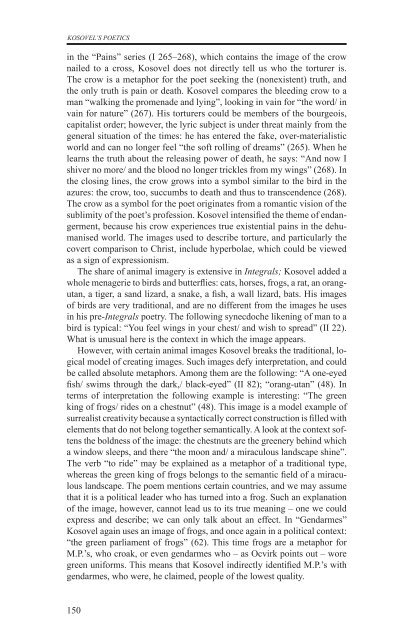razprave (pdf) - Društvo za primerjalno književnost - ZRC SAZU
razprave (pdf) - Društvo za primerjalno književnost - ZRC SAZU
razprave (pdf) - Društvo za primerjalno književnost - ZRC SAZU
- No tags were found...
Create successful ePaper yourself
Turn your PDF publications into a flip-book with our unique Google optimized e-Paper software.
KOSOVEL’s poeticsin the “Pains” series (I 265–268), which contains the image of the crownailed to a cross, Kosovel does not directly tell us who the torturer is.The crow is a metaphor for the poet seeking the (nonexistent) truth, andthe only truth is pain or death. Kosovel compares the bleeding crow to aman “walking the promenade and lying”, looking in vain for “the word/ invain for nature” (267). His torturers could be members of the bourgeois,capitalist order; however, the lyric subject is under threat mainly from thegeneral situation of the times: he has entered the fake, over-materialisticworld and can no longer feel “the soft rolling of dreams” (265). When helearns the truth about the releasing power of death, he says: “And now Ishiver no more/ and the blood no longer trickles from my wings” (268). Inthe closing lines, the crow grows into a symbol similar to the bird in theazures: the crow, too, succumbs to death and thus to transcendence (268).The crow as a symbol for the poet originates from a romantic vision of thesublimity of the poet’s profession. Kosovel intensified the theme of endangerment,because his crow experiences true existential pains in the dehumanisedworld. The images used to describe torture, and particularly thecovert comparison to Christ, include hyperbolae, which could be viewedas a sign of expressionism.The share of animal imagery is extensive in Integrals; Kosovel added awhole menagerie to birds and butterflies: cats, horses, frogs, a rat, an orangutan,a tiger, a sand li<strong>za</strong>rd, a snake, a fish, a wall li<strong>za</strong>rd, bats. His imagesof birds are very traditional, and are no different from the images he usesin his pre-Integrals poetry. The following synecdoche likening of man to abird is typical: “You feel wings in your chest/ and wish to spread” (II 22).What is unusual here is the context in which the image appears.However, with certain animal images Kosovel breaks the traditional, logicalmodel of creating images. Such images defy interpretation, and couldbe called absolute metaphors. Among them are the following: “A one-eyedfish/ swims through the dark,/ black-eyed” (II 82); “orang-utan” (48). Interms of interpretation the following example is interesting: “The greenking of frogs/ rides on a chestnut” (48). This image is a model example ofsurrealist creativity because a syntactically correct construction is filled withelements that do not belong together semantically. A look at the context softensthe boldness of the image: the chestnuts are the greenery behind whicha window sleeps, and there “the moon and/ a miraculous landscape shine”.The verb “to ride” may be explained as a metaphor of a traditional type,whereas the green king of frogs belongs to the semantic field of a miraculouslandscape. The poem mentions certain countries, and we may assumethat it is a political leader who has turned into a frog. Such an explanationof the image, however, cannot lead us to its true meaning – one we couldexpress and describe; we can only talk about an effect. In “Gendarmes”Kosovel again uses an image of frogs, and once again in a political context:“the green parliament of frogs” (62). This time frogs are a metaphor forM.P.’s, who croak, or even gendarmes who – as Ocvirk points out – woregreen uniforms. This means that Kosovel indirectly identified M.P.’s withgendarmes, who were, he claimed, people of the lowest quality.150
















